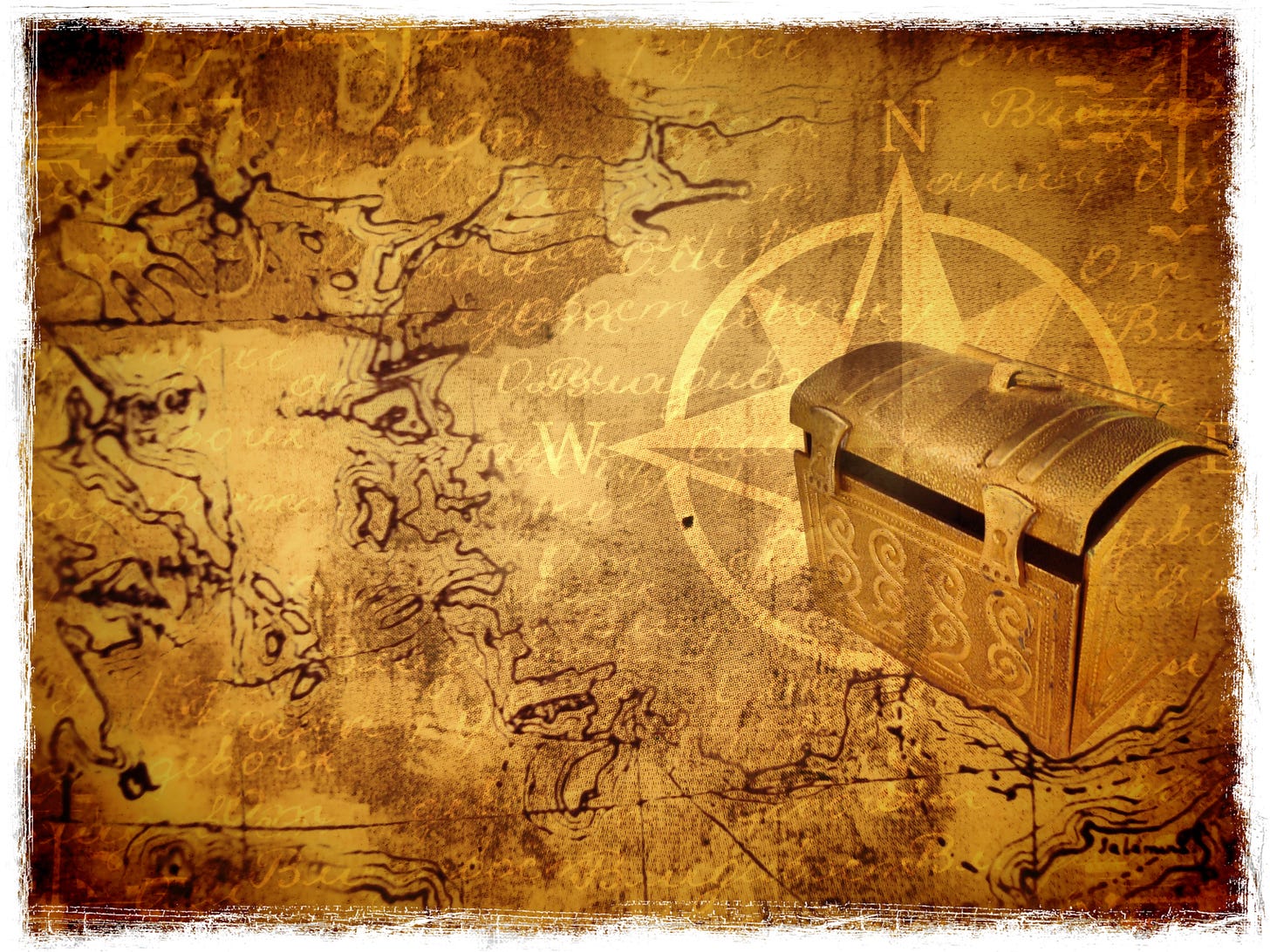Elevate Your Creative Life: The Treasure Map
an Inner Family map, a clue box, and a blueprint from my own Inner Family
Are you a first-time reader?
These posts make the most sense when you start here.
A Super Quick Review: remind me, why are we doing this?
I’m assuming that you, dear reader, are intellectually savvy, emotionally aware, and curious about different pathways for self-awareness in pursuit of an ever-evolving creative life.
The Inner Family, and specifically your Inner Teen, tenders just such a passageway because it expands your relationship with yourself beyond the occasional, daily ahas and insights.
And today, we’ll dive into the specifics of how you too can do this and where to start.
The Map: Exploring Your Inner Family
I’ve always been a sucker for information about our human brains, human development, anything and everything about what makes us tick. Plus, I relish the off-beaten track: spirituality, powers of our intuition, psychic phenomenon.
Growing up with a mother brimming with visions before things happened in time and space, my own quirky ability to drop into trance states to help a friend, here and there, and a child who talked to angels didn’t deter me from also loving science and research into the human condition.
Nurturing these apparently disparate natures encouraged me to be infinitely curious and unselfconscious about exploring whatever life offered.
So, graduate school in Creative Behavior and Human Development was my sandbox.
And the sandbox gave me a new set of tools that rocket-fueled access to my Inner Family: Lucia Capacchione’s book THE POWER OF YOUR OTHER HAND: A Course in Channeling the Inner Wisdom of the Right Brain.
Capacchione had a working theory that we can use our non-dominant hand (left for right-handed people / right for left-handed people) to access and articulate our internal experiences through writing and/or drawing.
The rationale goes like this:
Our dominant hand represents our dominant, conscious self. The one who insists we get up when the alarm goes off. Who decides when we pick up that fork to stab that piece of juicy, ripe tomato. Who insists I’m right! in an argument. And so forth.
Meanwhile, below deck are the sub-conscious galley slaves beholden to the booming dominant self/Captain to row when the Captain yells “Row!!!”
Sometimes, one of these galley slaves (an Inner Family Member) mutinies and takes over the ship (our bodies, our actions, our words).
When that happens, we usually find ourselves saying things like… I didn’t intend to do x, y, or z. I don’t know what I was thinking! That just popped out of my mouth! I can’t understand what happened! And so forth.
Capacchione’s method gives agency to the galley slaves.
Or in this case, to members of your Internal Family who can help you map out a new, expanded relationship with yourself in various capacities (friendship, parenting, partnering, business colleague, etc.), and in specific life circumstances (struggling with a decision, trying to put your finger on something, help in understanding a set of circumstances, envisioning or completing a creative project, etc.).
A Clue-Box for the Inner Family Blueprint
Once I discovered Capacchione’s treasure map, my Inner Family voyage became one of my most beloved, weekly rituals.
An example, and something I’ve mentioned before, is the connection with my Inner Teen, which turned into an inner-realm partnership that advanced the work on my dissertation in ways I never dreamed.
The Inner Family Blueprint is super simple:
1. The dominant hand/dominant self begins the process by asking questions.
2. Then switches the writing implement to the non-dominant hand/sub-conscious selves to answer.
3. If the non-dominant handwriting is illegible (happens!), just switch the pen/pencil back to the dominant hand and write the legible word above the illegible word. Then switch back to your non-dominant hand. This, fascinatingly, does not interrupt the process.
A few caveats to keep in mind:
1. This works best when you use paper and pen/pencil. Typing doesn’t access the same neural pathways.
2. This works best when you have dedicated, uninterrupted quiet time alone. Twenty to thirty minutes is a good start.
3. In the beginning, I recommend a box of tissues nearby. Emotions you might not expect will come up.
4. If you are dealing with trauma, or suspect trauma you haven’t yet uncovered, be sure you have strong emotional support in your circle of peeps.
Got it. So, Where Do I Start?
Great question.
Without a larger data base to work off of, my hunch is that our starting point has two possibilities.
One is based on a developmental sequence. You begin with your Inner Child and proceed in developmental sequence to whichever Inner Family Member wants to connect with you next.
It might be your three-year-old self, then your ten-year-old self, then maybe a jump to your thirteen-year-old self.
I suspect it also depends on how old you are when starting this journey.
Two is based on whichever Inner Family Member wants your attention right now. Then whichever Inner Family Member wants to be next. And next. And next.
There’s no right or wrong way to approach this. The biggest thing is to trust yourself. Be kind and patient with yourself. And let the words flow.
Your step-by-step, blueprint approach:
1. Think about whichever Inner Family Member you are connecting with as a shy fawn at the edge of the woods, eyeing you cautiously.
You are in the middle of the sun-dappled glade, present, sitting quietly, waiting for permission to connect. A light breeze rustles the wildflowers around you. The air is cool on your face. There’s a pungent green smell of leaves and wild grass. The fawn slowly begins to slide into the open edge of the glade.
You are in charge of the process, not dominantly, but in loving collaboration.
When you, and the Inner Family Member feel ready, pick up your pen/pencil and begin.
2. The 1st question: Just as you would when meeting a new friend, the first dominant-hand question begins with an introduction:
Hi, I’m [your name]. I’d like to know your name.
Then switch the pen/pencil to your non-dominant hand and allow this Inner Family Member to respond. Remember, what you hear in your brain most likely will not be what you are actually writing.
3. The 2nd question: [name of Inner Family Member], may I ask how old you are?
4. The 3rd question: [name of Inner Family Member], is there something you would like to tell me?
After this, just follow the conversation until its natural conclusion.
I usually like to end with a question. Something like this: Before we end, [Inner Family Member name], when, or how, would you like to connect again?
Remember, this approach is about giving agency to those parts of yourself who can open you wide to insights and awarenesses that you cannot reach by your mono, dominant, OneSelf alone.
Remember, this is a conversation. Switch back and forth between hands as the conversation needs. The right way is whatever turns out to be your way. Trust all of yourself.
For this you are not beholden to your eighth grade English teacher. Grammar, punctuation, spelling—these are tree roots ready to trip you right out of the process.
If you go back to Windywild’s most recent conversation with me, you’ll notice a few grammatical anomalies. It’s part of who she is and my adult self has no business correcting who she is.
The Panoply That Is Your Inner Family
To give you context:
I intentionally worked with this Inner Family approach, weekly, over a span of five years. After that, I connected with different Inner Family Members based on which life situation was happening and who was willing to jump into the fray.
During that time, different Internal Family Members popped up in surprising ways that had nothing to do with the dominant/non-dominant handwriting approach.
However, once a member showed up, I immediately began the writing process to 1) confirm that, indeed, here was one more member, and 2) expand my connection to myself.
I also learned, over time, which members were most helpful for which life situations. Then, when I was in need of inner guidance, I’d contact that member via the writing process.
For me, there is also an Inner Family Council. My Inner Teen, Windywild, alerted me to this phenomenon. Turns out, she was the one holding Inner Family Council meetings on her beach whenever she, or other members, wanted or needed a get-together.
Over time, here’s the succinct list of my Inner Family Members, besides my Inner Child and my Inner Teen, who showed up.
I suspect that my willingness to open this particular doorway to my inner realms, and pay attention, showed these other parts of myself that I was trustworthy to approach:
Shauna (my wise woman, who appeared on the other side of a large pond as I sat in my car on a cold, rainy day)
My Jungian animus (an older boy living on an Italian hillside, but of course!)
My male Inner Child (herding llamas somewhere in Peru), and…
Wanalee (Paul Bunyan’s female counterpart, who first appeared in a poem I wrote about “thighs the size of redwood trunks,” then again in an Authentic Movement session writing a poem that spanned 20 feet with each letter 2 feet high—all before I’d even heard of the Inner Family, and certainly had no idea she existed or what her name was).
What’s Next?
Actually, this time I have a request. As much as I love writing these weekly posts, it’s a lonely business and I have no idea how the Inner Family approach is landing for you.
Do you feel you have enough tools to jump in and explore this for yourself?
If you do decide to jump into your Inner Family voyage, I’d really love to know three things:
1) Are you’re on your way?
2) How’s it going for you?
And if you don’t feel ready, but you would like to explore the Inner Family, what else would be helpful?
You can hit “reply” (if you get this via email), or comment (if you’re comfortable sharing with more than just me inside the Substack platform).
Please know that, if you have any confounding questions, I’m absolutely here for you.
If you’re ready, since you’ve just completed the 9th post in this series, here’s the next in line, the 10th post: Adult Self, Time to Bend the Knee: Part 1 / Begin accessing the hidden reserves of your deepest wisdom
These posts will make the most sense if you read them in order, like chapters in a book.
Meanwhile, please…
Add a comment to this post because I really, really need to know what’s intriguing you, if there’s anything else you want to know/hear, or if you have a question or a thought. Controversy welcomed!
Tap the heart icon if you’re finding this thought-provoking or just because it lights up my day to know you’re out there and care
3. Discover why Inspiration changed from a what to a Who. Come Meet The Goddess of Inspiration and expand your creativity: an original, guided meditation for any time you hit a roadblock or doubts are taking over.
P.S. To continue this series, scroll down and hit “next.”
To reacquaint yourself with My Premise / My Promise, click here.










